Easter cactus plants are easy to grow and they require minimal care. In this post, I’ll show you all there is to know in order to keep them thriving and blooming for years to come.
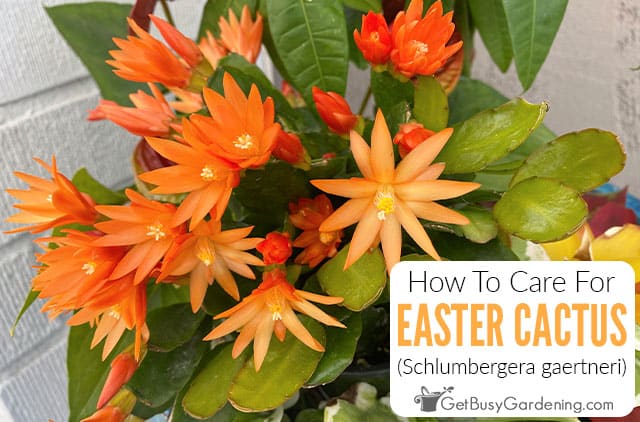
The Easter cactus and its spring flowers can be a lovely addition to any houseplant collection.
Even a beginner gardener can grow and rebloom them every year by learning to create the environment they need to thrive.
In this complete guide I’m sharing everything you need to know about growing an Easter cactus, so you can enjoy it for many years to come.
You’ll discover what water, soil, light, and fertilizer it prefers, learn about pruning and propagation, and so much more.
Easter Cactus Quick Care Overview
| Scientific name: | Schlumbergera gaertneri, Rhipsalidopsis gaertner, Hatiora gaertneri |
| Classification: | Succulent plant |
| Common names: | Easter cactus, spring cactus |
| Hardiness: | Zones 10-11 |
| Temperature: | 65-75°F |
| Flowers: | Orange, white, hot pink, purple, red, blooms late winter-spring |
| Light: | Partial shade |
| Water: | Consistently moist, do not overwater |
| Humidity: | High |
| Fertilizer: | Flowering plant food in spring and summer |
| Soil: | Fast-draining, sandy soil |
| Common pests: | Mealybugs, scale, fungus gnats |
Information About Easter Cactus
The Easter cactus (Schlumbergera gaertneri), or spring cactus, is named for the time of year that it typically blooms, which is in early spring right around the Easter holiday.
It’s been reclassified several times, so you may find it referred to as Rhipsalidopsis gaertner or Hatiora gaertneri.
Though “cactus” is part of their name, they’re actually epiphytic succulents which are native to the tropical rainforests of Brazil.
Instead of requiring soil to grow, they take in nutrients and moisture from the air and debris around them, like other holiday cacti.
The upright branches grow from woody stems and can reach 3’ long. They’re made up of oval leaf segments with rounded, scalloped edges.
Different Types Of Easter Cactus Plants
It’s important to know what type of Schlumbergera you have in order to understand when to expect the flowers.
Though the blooms come in various colors, there is only one true variety of Easter cactus, and it flowers in the spring.
You can identify it by the wide, flat leaves with rounded edges. If yours has toothed or teardrop shaped edges, you likely have one of the other types.
Spring Cactus Flowers
With the right care, you can enjoy blooms from your Easter cactus sometime between March and May.
Colorful, starburst flowers with slender petals form on the end of the branches. You can find them in several shades, including pale pink, lavender, white, red, and orange.

How To Care For Easter Cactus
Before we discuss how to care for Easter cactus, first we should chat about where they’ll grow best. Finding a good location is key to keeping them healthy.
Hardiness
Schlumbergera gaertneri is not a hardy plant, and will suffer if exposed to temperatures lower than 30°F.
They’re only perennials in zones 10-11. So if you live in a colder climate, you must bring them indoors for the winter.
Where To Grow Schlumbergera gaertneri
As an epiphyte, soil isn’t necessary to grow an Easter cactus. They can be mounted to boards or logs, or grown in trees in warm enough areas. But they can also thrive in a container that has good drainage.
They’re commonly kept as houseplants, but you can move yours outdoors to enjoy the warmth of spring and summer.
Outside, provide partial shade to keep them protected from the harsh sun and heat of the afternoon.
Move them indoors again when the temperatures drop in the fall, and place them in a spot with plenty of bright light.
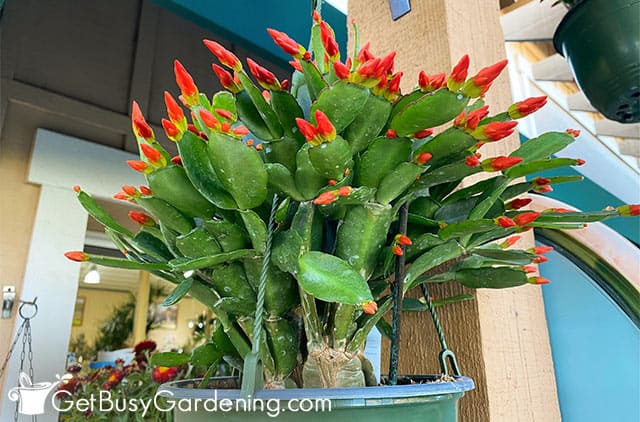
Easter Cactus Care & Growing Instructions
Now that you know where to grow it, let’s chat about what it takes to care for an Easter cactus. Creating an ideal environment is the best way to sustain healthy growth.
Light
Easter cactus prefers bright indirect light or morning sun. More than 6 hours of direct sun can cause reddening leaves or scorching, especially if it’s during the hottest part of the afternoon.
An east facing window is perfect for them inside. Outdoors keep them in partial or dappled shade.
In the winter they’ll need 12-14 hours daily of complete darkness to trigger reblooming. If their usual spot gets any light, even from artificial sources, move them into a closet overnight.

Water
The spring cactus is known to be temperamental about inconsistent watering. Too much or too little are both common causes of leaf drop.
Use a moisture meter to help you keep it consistent, but never wet or very dry. It’s also best to use room temperature instead of cold water.
Humidity
Natively, Easter cacti live in tropical humid environments, so they will do best when we recreate that at home.
Increase air moisture by running a small humidifier nearby, setting them on a pebble tray filled with water, or by misting 2-3 times a week.
Never leave water sitting on the leaves for very long however, as that can cause spots or rotting.
Temperature
The best temperature range for Schlumbergera gaertneri is 65-75°F, making indoor environments ideal. They can survive down to 30°F, but growth will be stalled, and anything colder will kill them.
High heat can cause burning, leaf drop, and wilting. Shade them during heat waves, and keep an eye on moisture to ensure they don’t dry out.
In the winter they’ll need an eight week cold period in order to set flower buds. To trigger blooming, keep the nighttime temps between 45-55°F, and daytime highs of 65°F.
Fertilizer
An all-purpose, balanced houseplant fertilizer, or those designed for flowering plants, are ideal for your Easter cactus.
Apply granules once a month from spring through fall. Or, use a diluted liquid option, like compost tea, every two weeks.
Soil
Although soil is not necessary for growing an Easter cactus, it can be a great medium for containers.
Choose a balanced, loose, well draining mixture, or one that is slightly acidic, with a pH between 6-7 on a testing probe. Or you can amend regular potting soil with perlite, and sand or bark.
For fun, you could try mounting one to a log or a board with sphagnum moss. Keep in mind that this will require more frequent misting and watering.

Repotting
Schlumbergera gaertneri will only need repotting if it’s outgrown the current container.
They actually prefer to be pot-bound and have shallow roots, so it may be many years before it’s needed.
Check for roots coming out of the drainage holes to see if yours needs a new container.
When it’s time, move up one pot size after it’s completely done blooming in late spring or early summer.
Pruning
There’s no need to prune an Easter cactus as part of their regular care, but it does encourage bushier growth. Two new pads will emerge from each place a cut was made.
Use sharp precision pruners to snip between leaf segments, or gently twist them off. It’s best to wait until summer to do this, when you see new growth forming after flowering.
Pest Control Tips
A healthy Easter cactus will rarely have pest issues, especially if kept indoors. But occasionally mealybugs, scale, or fungus gnats can become an issue.
Prune away heavily infested branches, and apply rubbing alcohol with a cotton swab to kill any insects on contact.
Insecticidal soap is also effective for washing the branches. You can be easily make your own by combining 1 teaspoon of mild liquid soap with 1 liter of water.
To get rid of persistent infestations or prevent recurring outbreaks, try using neem oil routinely.
Dormancy & Reblooming
Every winter Schlumbergera gaertneri needs to enter a dormant period in order to trigger blooming the following spring.
If possible, move it to a shaded outdoor area from midsummer through early fall to start the process. Bring it back in before temperatures drop too low, and water more sparingly.
In late December or early January, make sure it receives at least 12 hours of complete darkness every night for eight weeks, and keep the temperature between 45-65°F.
After the eight week dormancy period, move it back to a spot with plenty of indirect light, and flower buds should begin to appear by late February or March.
Related Post: How To Care For An Orchid Cactus Plant (Epiphyllum)
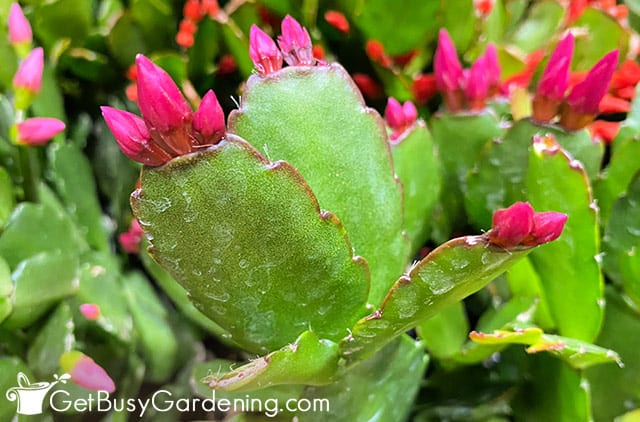
Easter Cactus Propagation Tips
An Easter cactus is easy to propagate with stem cuttings. Wait until all flowering has finished for the year, then take segments of 3-4 leaves from healthy branches.
Allow them to callous for a few days. Dip the cut ends in rooting hormone, then place them in a damp, loose rooting medium and water sparingly. In 3-4 weeks, they should begin to root.
Troubleshooting Common Easter Cactus Problems
The Easter cactus has a reputation of being very finicky to care for. If you run into any of these common issues, use my tips to help get it back in healthy shape.
Leaves Or Segments Falling Off
When an Easter cactus drops leaf segments, it’s usually due to improper watering, exposure to temperature extremes, or hot or cold drafts.
Ensure the soil stays evenly moist but not wet or completely dry. A moisture gauge can be very helpful in getting that just right.
Keep them in moderate temperatures, and avoid locations near a heater vent, fireplace, or cold drafty window.
Spring Cactus Not Blooming
Schlumbergera gaertneri may not bloom due to age, depleted soil, or lack of proper dormancy conditions.
Ensure they’re getting cool, dry temps and complete darkness for twelve hours a night for eight weeks during the winter months.
If yours is older, try pruning it to reinvigorate growth, which can help it bloom the following year.
It’s also a good idea to fertilize old soil to make sure it has plenty of nutrients for your spring cactus to absorb.
Plant Is Limp / Drooping
Limp or drooping leaves can be caused by improper watering, heat, or too much direct sun.
Don’t saturate them to the point of puddling, or ever leave it sitting in water. Try to avoid extended periods of dryness as well. Also, make sure it’s in an area protected from the heat and afternoon sun.
Flower Buds Dropping
Most often flower buds drop due to inconsistent moisture, or when the plant is moved while they are setting.
Once the buds begin to form, avoid moving it from its current location, and keep the soil evenly moist. Also, try to protect it from drafts, like open doors, windows, or heating vents.
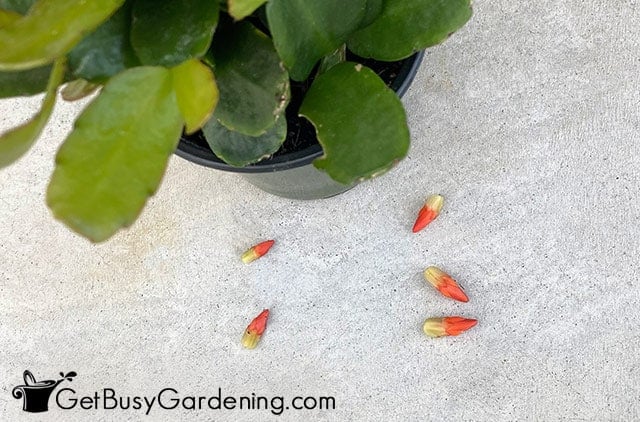
FAQs About Easter Cactus Care
Here I’ve answered some of the most commonly asked questions about Easter cactus care. If yours isn’t listed, please add it to the comments section below.
Are Easter cactus plants easy to care for?
Easter cactus plants have a reputation of being finicky, but can be easy to care for once you understand their water, temperature, and light needs.
How long does a spring cactus bloom?
A spring cactus can bloom from March all the way through May, if provided the correct care and dormancy conditions in the winter.
Does an Easter cactus bloom every year?
An Easter cactus can bloom every year if given the right care and winter conditions. However there may be years that it skips flowering, especially if recently repotted.
How fast does an Easter cactus grow?
An Easter cactus grows fairly slowly, and will only put on a set or two of new leaves on each stem per year.
Can I put my spring cactus outside?
Yes, you can put a spring cactus outside when the temperature is consistently above freezing. But be sure to protect it from the hot afternoon sun, and move it back inside before temperatures drop in the fall.
With the care tips provided in this guide, you have everything you need to start growing Easter cactus at home. Enjoying beautiful blooms every spring is a great reward for learning how to care for them correctly.
If you want to learn all there is to know about maintaining healthy indoor plants, then you need my Houseplant Care eBook. It will show you everything you need to know about how to keep every plant in your home thriving. Download your copy now!
More Holiday Plant Care Guides
- How To Care For A Christmas Cactus Plant (Schlumbergera buckleyi)
- How To Care For A Thanksgiving Cactus Plant (Schlumbergera truncata)
- How To Care For Cyclamen Plants
- How To Care For An Amaryllis Plant
- How To Care For Poinsettia Plants (Euphorbia pulcherrima)
Share your easter cactus care tips in the comments section below.
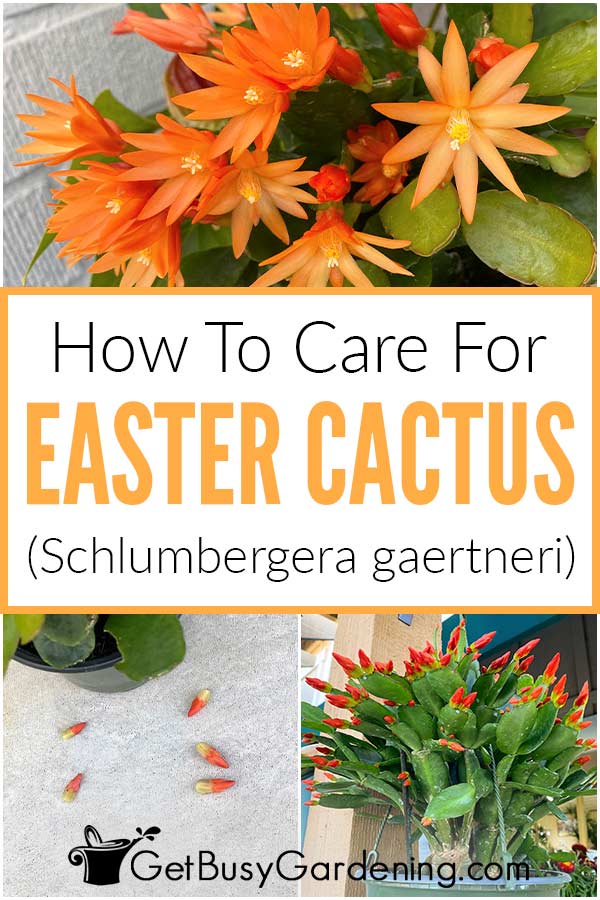





Roxanne Turpin says
Well, I did what you suggested and got amazing orange flowers! Alas…now the plant looks like it’s dying. sort of starved. I think it needs repotting. I’ve given it a few good soaks since the flowers dropped off and let it go dry but the “leaves” are looking like the life was sucked out of them.
Opinion?
Amy Andrychowicz says
I’m so happy to hear that your Easter cactus bloomed, congratulations! If the leaves look dehydrated even after watering, the I’m worried that it might have root rot. 🙁 Check the soil first to see how wet/dry it is. If it’s bone dry and the water runs right through the pot, then you may need to soak it so the soil can absorb water and rehydrate the plant. However if it’s wet or moist at all, then it may have been overwatered at some point. If that’s the case, try taking cuttings of healthy stems and see if you can root them just in case.
Roxanne Turpin says
A friend who moved to a much smaller space gave me her Easter cactus. The center of the plant (I assume the oldest parts) leaves are a silvery green, while the rest of the plant is normal green.
Is this silvery thing just because the plant is old? I have it under a plant light right now and I’m misting it and it’s showing some new growth, but I think I need to get it into dormancy (January 18th).
Thanks in advance for your help.
Amy Andrychowicz says
Yes, it’s normal for the bottom of easter cactus branches to turn brown/woody and harden as they age, starting with or silvery color as you mentioned. And yes, now is the time to put it into dormancy if you want spring flowers.
Roxanne Turpin says
Thank you so much!
Amy Andrychowicz says
You’re welcome!
Prab says
Should overhanging stems be kept off any table by raising the container on support blocks ?
Amy Andrychowicz says
There’s no need to keep the overhanging Easter cactus stems off the table, it won’t harm them. But if you’d like them to drape down more for a showier display, then you certainly could prop the pot up higher or try hanging it.
Kelly says
Thanks for the great tips! I’ve had my Easter cactus for a few years now and it’s always been a healthy plant. I’m definitely going to start following your advice on watering and feeding it. Thanks again!
Amy Andrychowicz says
You’re welcome, so glad you found my Easter cactus care tips so useful! Good luck with your plant.